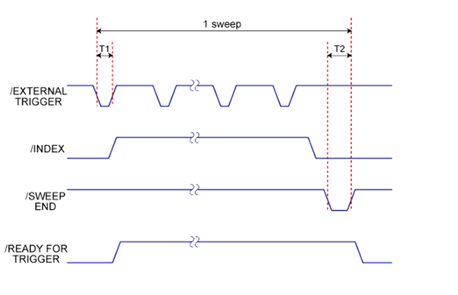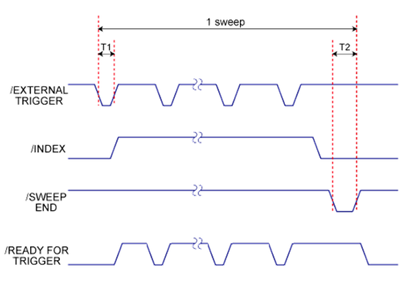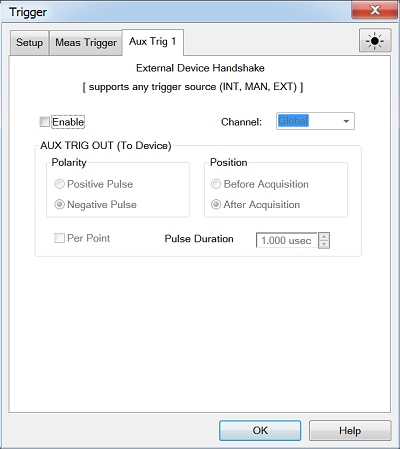
See how to access the Trigger Dialog
Trigger Ready and Trigger IN
The Trigger connectors are located on the rear-panel.
These signals can be used when the VNA is communicating with a slow mechanical device. A material handler is very mechanical and takes a relatively long time to load and discharge parts. Here is how these signals work together to communicate:
-
The VNA sends a 'Ready' signal when it is ready to make a measurement.
-
The external device sends a trigger signal to the VNA when it is ready for a measurement.
Dialog Settings
To cause the VNA to respond to Meas Trig IN or Handler I/O signals, select External on the Trigger Setup tab, Source setting.
Also on the Trigger Setup tab, Scope setting, choose whether one external trigger signal will apply to ALL channels (Global) or one trigger signal per Channel. The following settings apply accordingly.
Main Trigger Input
Global / Channel Trigger Delay After an external trigger is received, the start of the sweep is held off for this specified amount of time plus any inherent latency.
-
When Trigger Scope = Channel, the delay value is applied to the specified channel.
-
When Trigger Scope = Global, the same delay value is applied to ALL channels.
Source The VNA accepts Trigger IN signals through the following connectors:
-
Meas Trig IN BNC
Level / Edge
Positive Edge After the VNA arms, it will trigger on the next positive edge. If Accept Trigger Before Armed is set, the VNA will trigger as soon as it arms if a positive edge was received since the last data was taken.
Negative Edge After the VNA arms, it will trigger on the next negative edge. If Accept Trigger Before Armed is set, the VNA will trigger as soon as it arms if a negative edge was received since the last data was taken.
Accept Trigger Before Armed When checked, as the VNA becomes armed (ready to be triggered), the VNA will immediately trigger if any triggers were received since the last taking of data. The VNA remembers only one trigger signal. All others are ignored.
-
When this checkbox is cleared, any trigger signal received before VNA is armed is ignored.
-
This feature is only available when positive or negative EDGE triggering is selected.
-
Configure this setting remotely using (SCPI) or (COM).
Low latency mode: - When checked, variations in delay time between the reception of a trigger and the start of a one-point measurement are decreased for point trigger measurement. However, the /READY FOR TRIGGER does not output for each points at this mode.
-
Point Trigger: ON, Low Latency: ON

-
Point Trigger: ON, Low Latency: OFF

Ready for Trigger Indicator (Trigger Ready)
On the VNA, when External is selected on the Trigger Setup tab, then both Meas Trig IN and Meas Trig Ready are enabled.
Choose a connector to send the VNA Ready OUT signal:
-
Handler I/O p21
Choose Polarity of the 'Ready OUT' signal.
-
Ready High - TTL High indicates the VNA is ready for trigger.
-
Ready Low - TTL Low indicates the VNA is ready for trigger (default setting).

